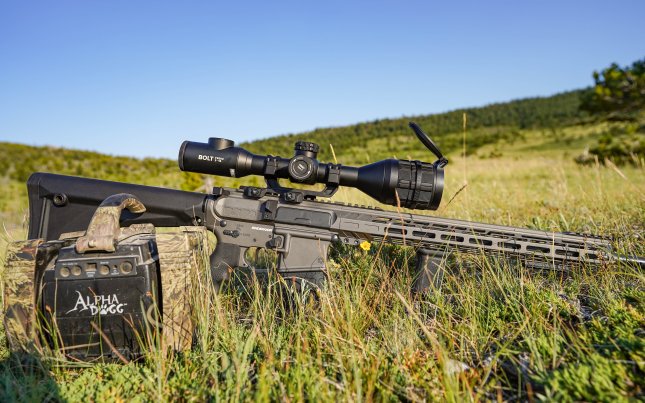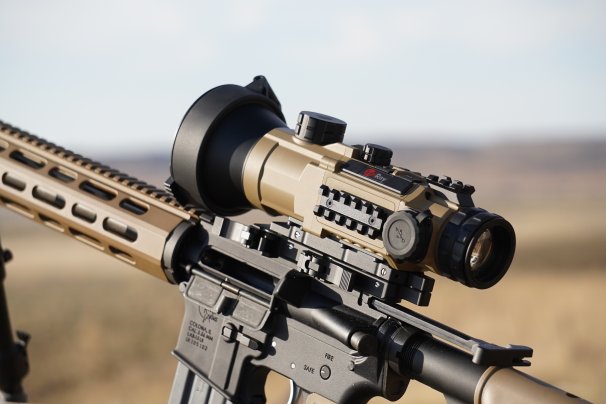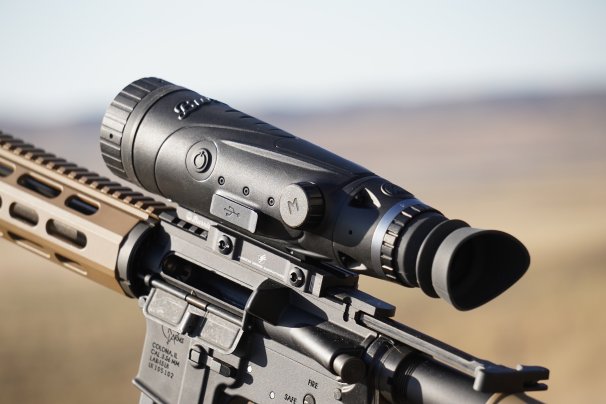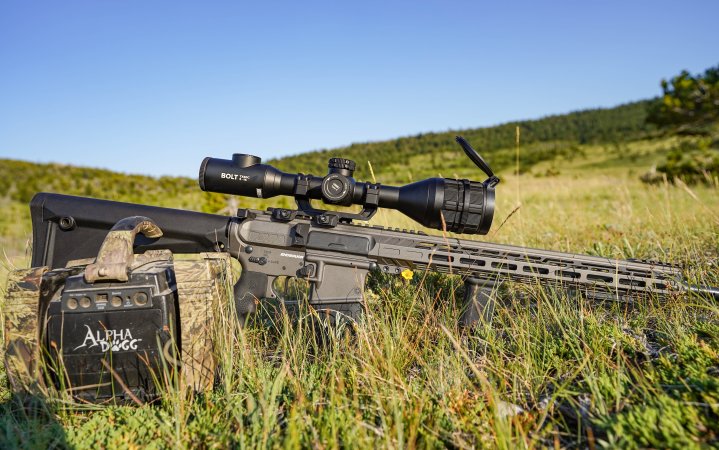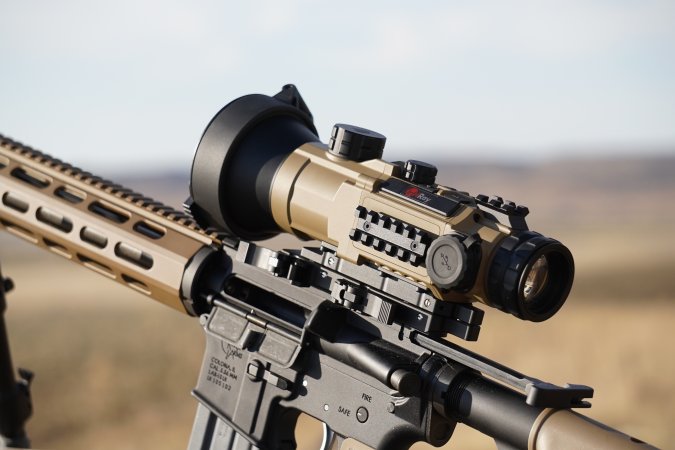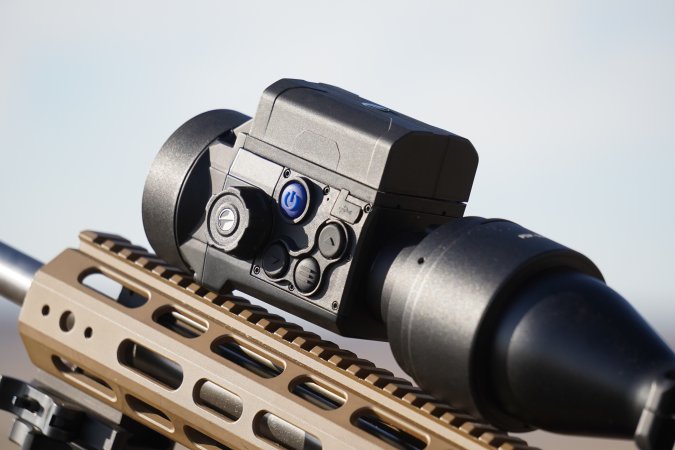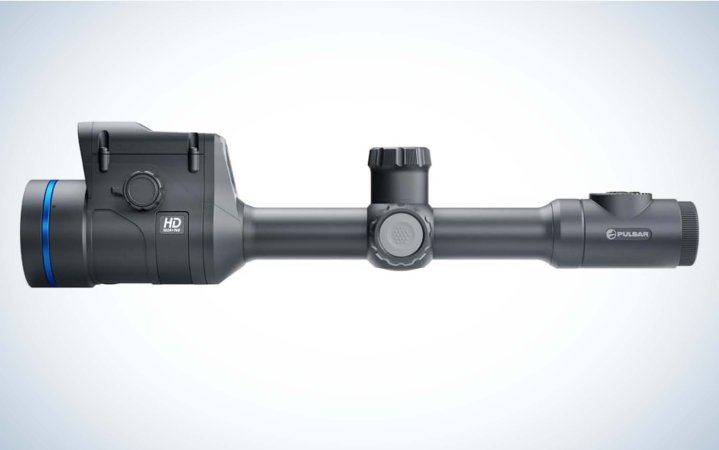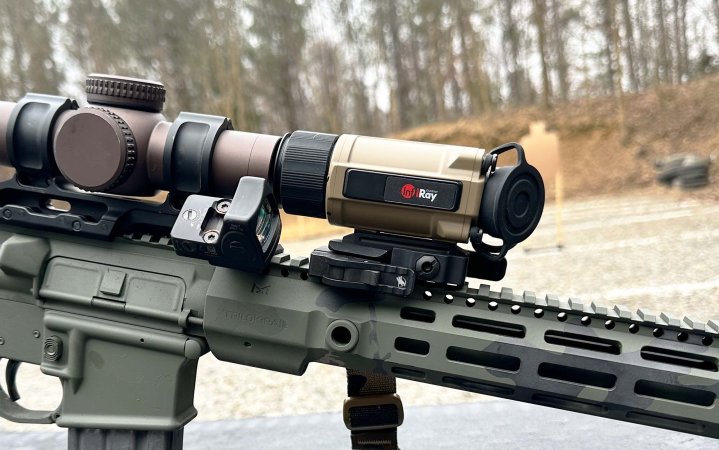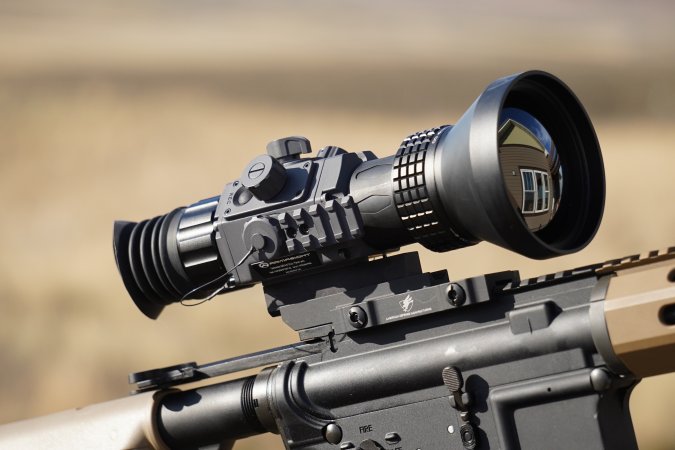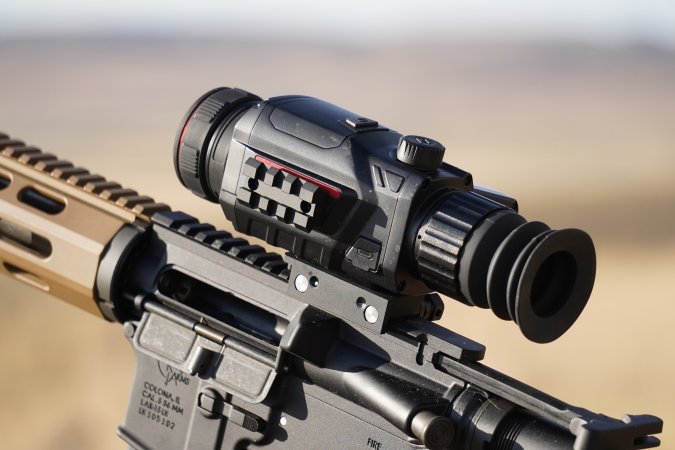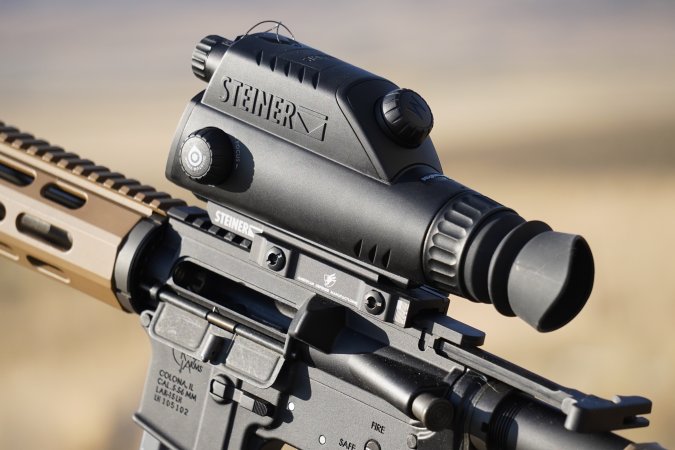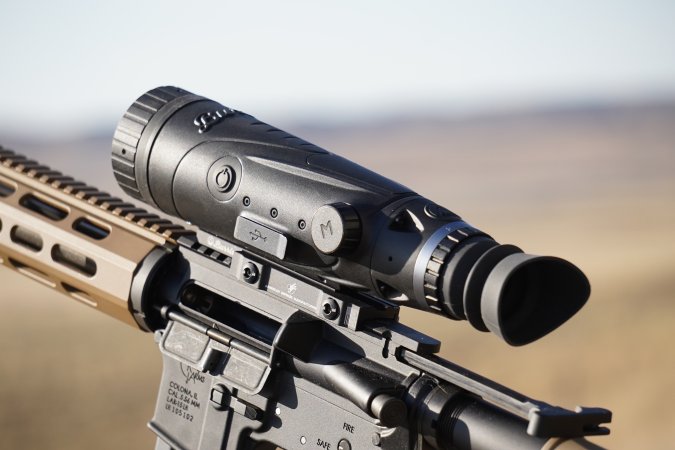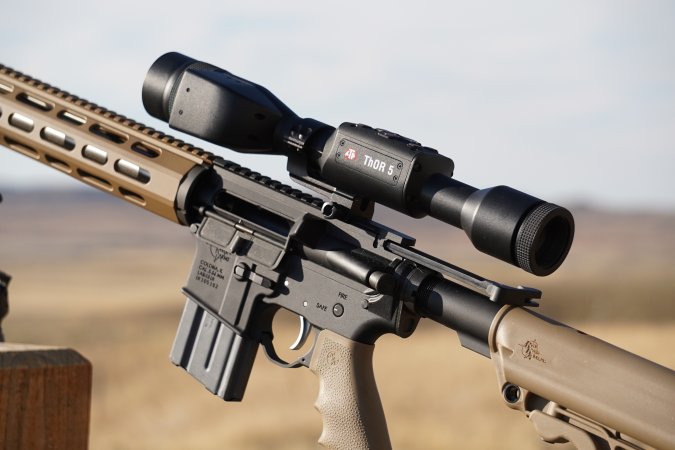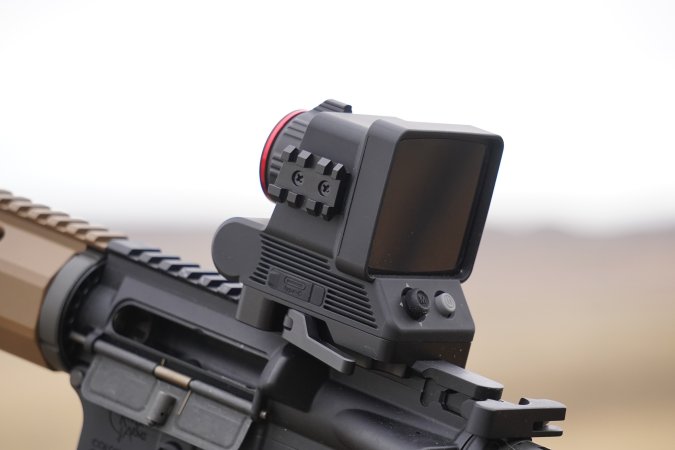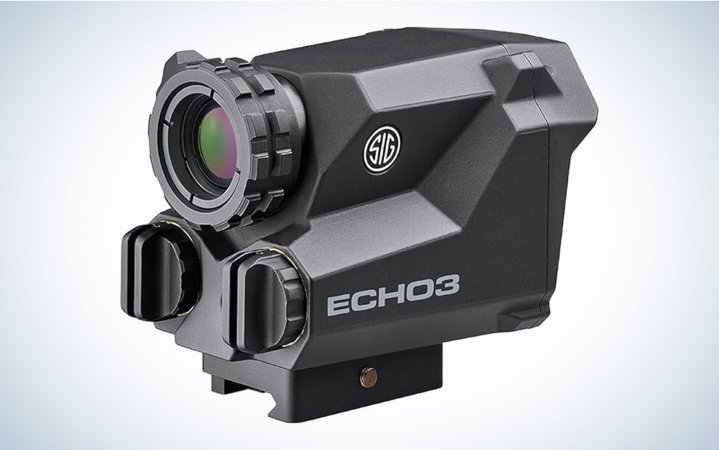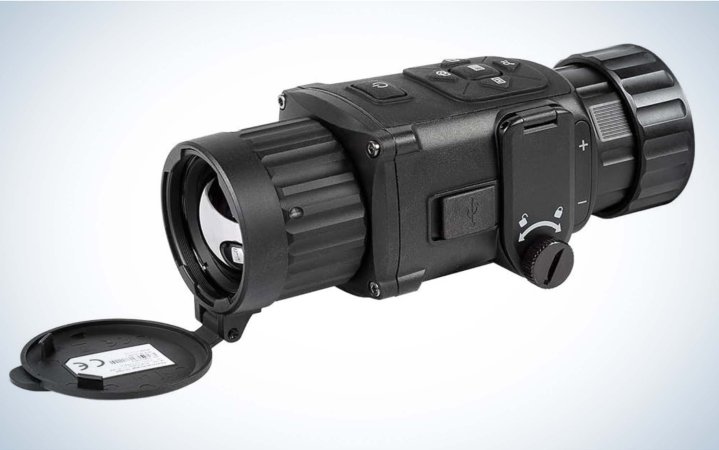We may earn revenue from the products available on this page and participate in affiliate programs. Learn More ›
Not long ago, thermal scopes were superfluous gadgets. Now, they’re essential kit for serious predator and hog hunters.
This collection of thermal sights includes military-grade scopes that cost more than your daughter’s car and entry-level scopes that can get just about any hunter into the nocturnal coyote-hunting game.
While this isn’t a comprehensive review of all the thermal sights on the market, it’s a pretty good collection of new products that were submitted for Outdoor Life’s benchmark optics test. We added a few items that we tested last year in order to reflect the type of thermals you’ll find online and at retail outlets. Our testing methodology is designed to tease out the authentic products from the overpriced clones and to make you a smarter, more informed buyer when you decide to get serious about adding a thermal to your hunting gear. Here are our picks for the best thermal scopes based on our hands-on testing.
- Editor’s Choice: InfiRay BOLT TX60C
- Best Long-Range: InfiRay RICO Hybrid 640
- Best Clip-On Thermal: Pulsar Krypton FXG50
- Most Versatile: iRay RICO MICRO V2
- Best Hog-Killing Thermal: Pulsar Thermion 2 LRF XL50
- Most Durable: Armasight Contractor 640 3-12×50 Thermal Weapon Sight
- Best New Thermal Sight: X-Vision Impact 350
- Best Hunting Thermal Sight: Steiner Nighthunter S35 Gen II
- Great Buy: Burris BTS35 v3
- Best Laser-Rangefinding Thermal Scope: ATN ThOR5 LRF
- Best Thermal Reflex Sight: X-Vision Flex 2
- Best Large-Caliber Thermal Rifle Scope: Trijicon REAP-IR 60
- Best Entry-Level Thermal Scope: Sightmark Wraith Mini Thermal
- Best AR Thermal Sight: Sig Echo3
- Best Value Clip On: AGM Rattler TC35-384 Thermal Clip-On
How We Tested the Best Thermal Scopes

There’s really no substitute for field time with thermal devices. You can read their specifications and compare attributes without handling the units, but reading about digital resolution or video-recording capabilities can’t measure how long the batteries last in a cold winter night on the prairie, or how precise a built-in “stadiametric” rangefinder is at ranging targets in the dark, or how easy the controls are to manipulate while wearing gloves.
Our test is designed to compare and contrast the specs of each submission, but then determine how they perform in the field. The Outdoor Life optics test team gave each product a preliminary spin, but later in the fall my assistant, coyote-hunting addict Kaden Fossum, and I spent several months with these units. We took each thermal scope on a series of coyote hunts, where we each recorded our activities, often literally, with the onboard image- and video-recording capabilities of each unit. We compared their display resolution, their thermal sensitivity, and their ease of use.
Unlike Outdoor Life’s binocular test, in which each attribute is assigned a specific numeric score and overall point totals determine each optic’s place within the field, Fossum and I compared notes of the thermals to arrive at conclusions and rankings. It’s less analytic than impressionistic, but that suits the category, since so many performance attributes of thermals are defined by technical specs. A thermal with a sensor resolution of 640×480 and a 1024×768 display is going to look like the next thermal, from another brand, with the same specs. Same with color palettes, which are pretty much the same from model to model.
Instead of measuring spec-driven performance, Fossum and I rated each unit on these criteria:
- Ease of set-up, which includes mounting, zeroing, and reticle adjustment
- Connectivity, which includes interface with mobile app, ability to connect to Bluetooth and WiFi, ability to customize ballistic inputs, and image capture and sharing
- Thermal Performance, which includes refresh rate, number and variety of color palettes, detection distance, contrast, and both daytime and nighttime visibility
- Shootability, which includes button ergonomics, eye relief, magnification, and features like picture-in-picture displays, and rangefinding
- Field-Worthiness, which includes durability, battery life, and versatility
- Price Value, which is an assessment of how much instrument you get for your money
After assessing all these inputs, we determine if a thermal sight is especially well-suited for a particular activity and give it a Best For… citation in order to help readers determine which unit is the best for their particular pursuit and budget.
Best Thermal Rifle Scopes: Reviews & Recommendations
Editor’s Choice: InfiRay BOLT TX60C
Pros
- Supported by excellent InfiRay Outdoor app
- Excellent 30mm quick-detach scope mount included
- Objective lens focus lever
- 7 color palettes (white hot, black hot, red hot, color, violet, crimson, Veridian)
- Picture-in-picture mode
- Intuitive three-button controls
Cons
- At around $7,000, a hefty investment
- Battery access caps are easy to cross-thread
- Image pixelates at higher magnification
Score Card
- Ease of Set-Up: Excellent
- Connectivity: Very Good
- Thermal Performance: Excellent
- Shootability: Excellent
- Field-Worthiness: Excellent
- Price/Value: Fair
Key Feautres
- High-definition 1024×1024- microbolometer thermal sensor
- 3-16x magnification
- 2560×2560 round AMOLED display
- 60mm objective lens
- Recoil-activated video
- Compatible with external laser rangefinding module
- Accepts standard 18650 batteries
- 7 reticle choices
The most consistent and enduring dig on thermal optics is that the image they deliver is grainy, dull, and unfocused. Even in the best conditions, these devices can’t match the sharpness of traditional optics. The resolution of thermals’ sensors and displays are far less than that of your mobile phone or laptop computer screens.
The reason, of course, is that the image that reaches your eye behind a thermal is a digital depiction of reality, and the factor that limits sharpness is a combination of pixels and processors that turn tiny differences in detected temperature into images our brains can comprehend.

It’s expensive to boost digital resolution. That’s why thermals with high-resolution sensors cost much more than those with lower-resolution sensors. Many thermal brands “cheat” by providing software solutions that sharpen and brighten images. But the new InfiRay Outdoor BOLT TX60C thermal scope features a premium 1024×1024 sensor that’s double the resolution of most of its competitors. Even more remarkable, its display resolution is 2560×2560 and round to provide corner-to-corner clarity. That investment in image processing results in a noticeably sharper and more resolved image compared to the InfiRay’s peers.
The optical horsepower of the BOLT puts it in a class by itself, but it has tons of other features that make it a fast, smart, intuitive, and highly effective hunting and shooting rig. Taken in total, the InfiRay BOLT TX60C handily wins our Editor’s Choice award as the top thermal scope of the year.
You’ll pay for this level of performance. Priced at $6,999, the BOLT is an expensive product, but it not only represents the next generation of thermals, but considering all its talents, it’s not out of line with the price of lower-performing competitors.
Operationally, the BOLT is simple and intuitive. In place of a traditional scope’s elevation turret, the BOLT has a push-and-turn control that operates its extensive electronic menu. Near the eyepiece is a 3-button control that activates the photo/video mode, palette choice, and image brightness. The controls are easy to use with gloved hands, and riffing between modes and menu choices is among the simplest of any unit in our test.
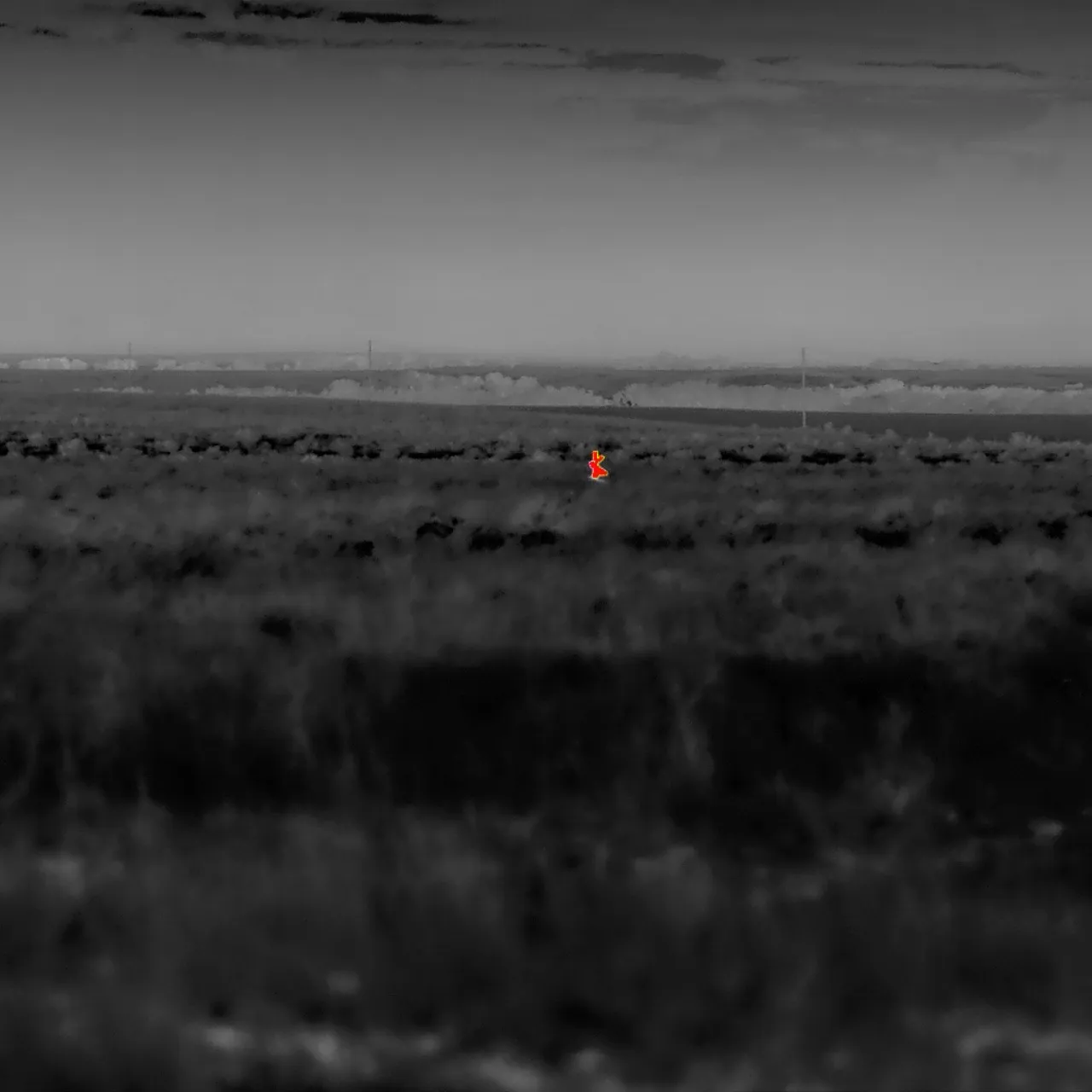
Externally, the BOLT has an objective lens focus with a retractable throw lever that makes fine-tuning focus easy and fast in the field. The unit has a recoil-activated video mode that automatically records 30-second clips before and after a shot. And the InfiRay has one of the simplest battery systems in the field. Users can plug the scope into a wall mount with a USB cable, or they can use standard 18650 batteries, swapping them in and out in the field. Add an inclinometer, choice of seven reticles, seven color palettes, and a compass-activated directional orientation, and this thermal scope wins on attributes alone.
Add a best-in-class quick-detach Picatinny rail mount, and you have an investment-grade thermal that should provide years of excellent operation and imagery, with software upgrades provided by the excellent InfiRay Outdoor app.
Best Long-Range: InfiRay RICO Hybrid 75 640
Pros
- Supported by excellent InfiRay Outdoor app
- Ships with robust quick-detach cantilever rail mount
- Ambidextrous objective lens focus Intuitive button functionality
- 10 electronic reticles
- Picture-in-picture mode
Cons
- At around $8,000, a hefty investment
- Significant battery drain in cold weather
- Sluggish performance when rangefinder and image capture operate concurrently
Score Card
- Ease of Set-Up: Very Good
- Connectivity: Very Good
- Thermal Performance: Excellent
- Shootability: Very Good
- Field-Worthiness: Good
- Price/Value: Good
Key Features
- Sensor Resolution: 640×512
- 75 mm objective
- Detection Range: 3600 Yards
- Sensor Frame Rate: 50hz
- Optical Magnification: 4X
- 8x digital magnification
- Onboard laser rangefinder
- 6 hour run time
We greeted InfiRay’s claim that the RICO Hybrid scope could detect deer-sized objects out to 3,600 yards with a big dose of skepticism. After all, that’s a lot of real estate for any optic, especially in the veiling darkness of night. But at this year’s Outdoor Life optics test, we used the Hybrid to scan the miles-distant face of the soaring Rocky Mountain Front, and damned if we didn’t detect an animal — it might have been a cow moose or a young bull elk — feeding out of a cottonwood bottom and grazing on a foothill pasture, at 1 in the morning.

The next day, we ranged the spot. It was two miles away, 3,311 yards, to be exact. InfiRay’s claims are spot-on. This is a serious, expensive, and very capable thermal scope, and if you have $8,000 laying around, you should run to a retailer or internet site to buy this. It’s that good.
It’s actually a little too good. We’ve been used to rating the relative merits of thermals based on their sensor and display resolution. Those with higher-resolution innards generally deliver better imagery, and since this is a test of optics, image is everything. Well, almost everything.
This is one of the few cases in thermal devices where lowish sensor resolution doesn’t necessarily result in disappointing performance. The RICO Hybrid scope has a fairly pedestrian sensor resolution of 640×512 microbolometers, which should produce a forgettable image. But InfiRay has combined a huge 75mm objective lens (a 50mm lens is also available) with a high-resolution 2560×1920-pixel display, and a sophisticated digital processor to boost the image, creating sharp, immersive, three-dimensional images out of quavering nocturnal targets.
The Hybrid has a number of other appealing features for thermal hunters. It ships with a built-in Picatinny mount that easily mates to most rifle rails, and it has a couple of other integrated Pic rails that accept accessories, including a sold-separately InfiRay laser rangefinder module. Its controls are simple and easy to use at night. Those include a dial focus control that’s easy to use with gloved hands, and a smaller dial that controls the internal menu.
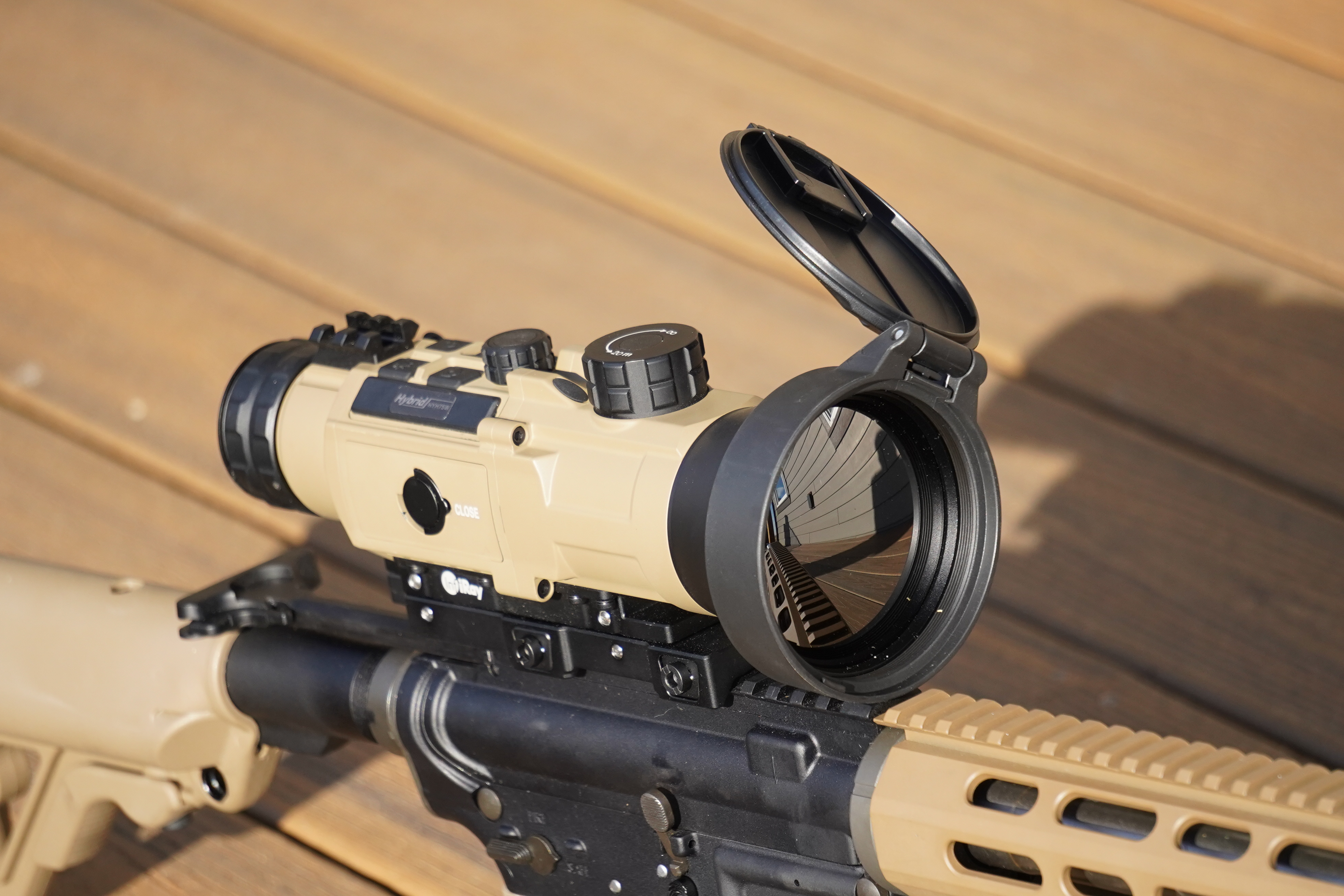
The device captures both photos and videos, and sharing them through the InfiRay Outdoors app is easy and simple. Users can also choose to manually download images stored on the 64 GB onboard memory of the RICO. The unit has a recoil-activated video capture mode that allows users to capture 30 seconds before and after the trigger is pulled. Run time on the rechargeable batteries is about 6 hours, depending on how much recording you do, and given the great image capture of this device, you’re going to do a lot of videoing.
There are some important downsides to this hefty thermal scope. The first is its physical size. It weighs 2.8 pounds, so you’d better have a good bipod or tripod to handle the weight of the optic and your rifle. And it’s undeniably expensive, especially when you consider that a laser rangefinder will cost another $800 to add a Bluetooth-connected rangefinder to this unit.
But for a thermal scope that will fully reveal the far-away world at night, and will help shooters place bullets thanks to customizable reticles, this scope is in a class of its own. When you consider that it also performs as a very competent hand-held thermal viewer, the sticker shock is a little less, well, shocking.
Read Next: Best Thermal Monoculars
Best Clip-On Thermal: Pulsar Krypton FXG50
Pros
- Supported by excellent Stream Vision 2 app
- Mounts on standard daylight scope
- Doubles as thermal monocular
- 11-hour battery run time
- Rugged magnesium alloy housing
- Mounts to either rail or slave scope
Cons
- At around $4,500, a hefty investment
- As a scope, must be used with secondary optic
Score Card
- Ease of Set-Up: Very Good
- Connectivity: Excellent
- Thermal Performance: Very Good
- Shootability: Very Good
- Field-Worthiness: Good
- Price/Value: Good
Key Features
- 640×480-microbolometer thermal sensor
- 3x magnification
- 1920×1080-pixel display resolution
- 2300-yard detection range
- 16-gigabyte onboard memory
- Lightweight – 18 ounces
- Kit includes adapters for wide variety of slave scopes
For some reason, American hunters haven’t fully embraced the elegance, simplicity, and versatility of clip-on thermals. Our European peers pioneered the use of clip-ons, which use traditional daylight scopes as slave optics, with the thermal unit literally “clipping-on” to the objective bell of the scope. The design dominates in Europe, largely because hunters don’t have to swap out their main rifle scope in order to add thermal capability.
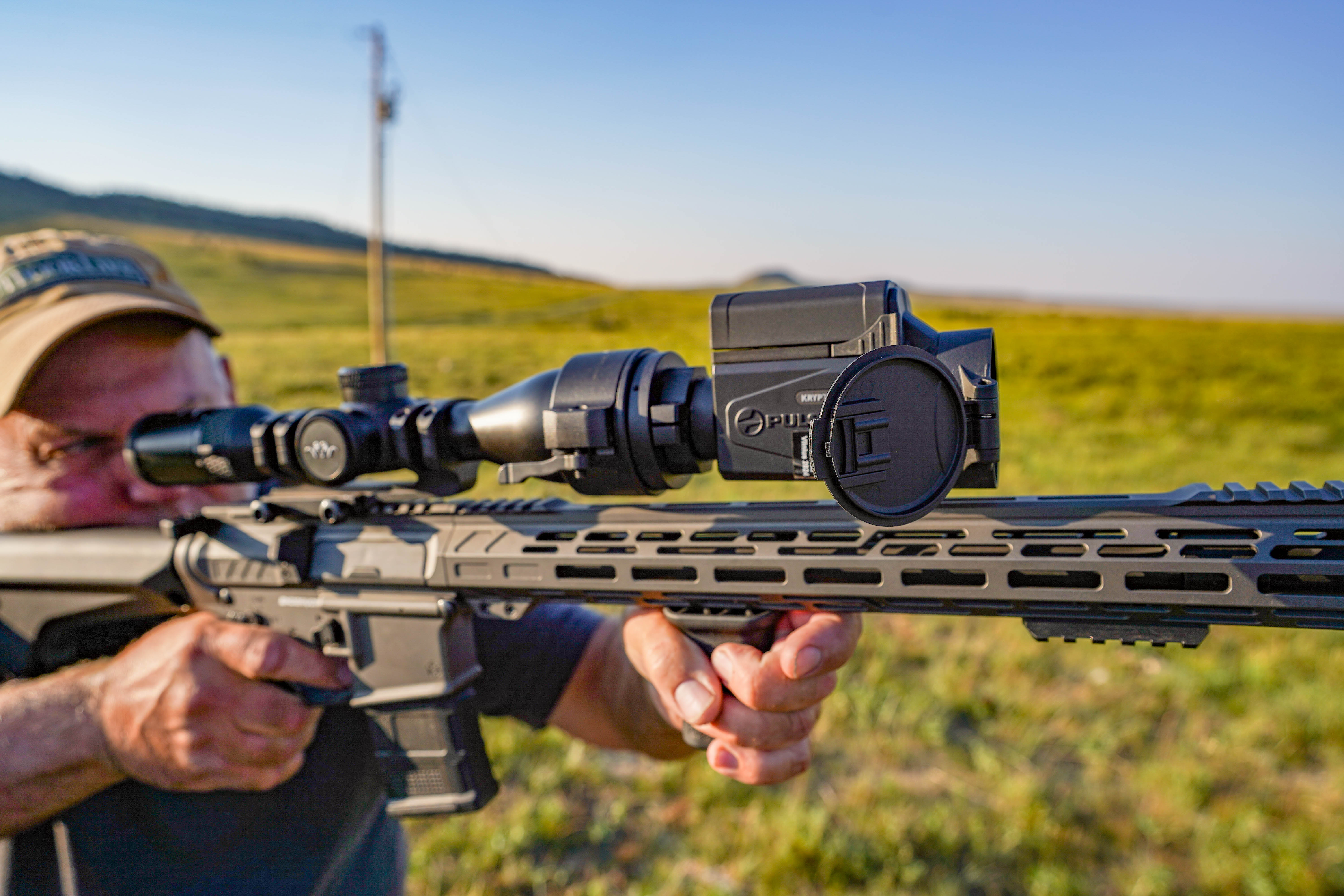
That’s probably because gun ownership is limited in Europe, and most hunters there don’t have a dedicated night-hunting rifle.
But it really is a sensible way to add thermals to your existing arsenal. Clip-ons tend to be less expensive than dedicated thermal scopes, and they often have better electronics and recording capabilities because they’re not dedicating so much room and battery power to generating images.
If you’re looking for the best of the clip-on world, Pulsar’s Krypton2 is a good place to start. It features an excellent 640×480 12-micron sensor, a high-resolution 1920×1989 AMOLED display, 2,500-yard detection range, and a whopping 11-hour battery life, thanks to a backpack battery that clips right to the top of the unit. Adding to its value and versatility, the Krypton2 doubles as a thermal imaging device when paired with Pulsar’s monocular.
One of the arguments for clip-ons is their relatively clear image. Because they use the magnification of the slave scope to enlarge the digital image, they’re largely free of the extreme pixelization that occurs when most thermals zoom in. The Krypton2 has a fixed 3-power magnification, obviously more than the 1X of most clip-ons, which gives it a bit more reach while still delivering a clean, crisp image.
Pulsar ships the Krypton2 with a whole series of adapters to fit a wide variety of rifle scopes. It connects to the very good Stream Vision 2 app that allows users to remotely control the device, stream video from the clip-on, and easily record and share photos and videos. Significantly, it also allows users to upload photos and video to a Stream Vision cloud storage.
Operationally, we had no quibbles with the short, light, durable unit. It has all the functionalities you’d expect – eight color palettes, intuitive arrangement of buttons that are easy to reach from the front of the scope, and 16 GB onboard image storage. But the Pulsar also has the ability to calibrate the unit’s display so it centers in your rifle scope’s exit pupil, a key feature to align the thermal with the daylight optic.
We do have a quibble with Pulsar’s naming convention, though. Would-be buyers should be aware of the significant differences between the Krypton2 FXG50, which we tested, and the FXQ35, which has a lower-resolution sensor and decreased operating range.
Best Hog-Killing Thermal: Pulsar Thermion 2 LRF XL50
Pros
- Supported by excellent Stream Vision 2 app
- Mounts on standard 30mm rings
- Ambidextrous objective lens focus
- Intuitive button functionality
- 10 electronic reticles
- Picture-in-picture mode
Cons
- At around $8,000, a hefty investment
- Significant battery drain in cold weather
- Sluggish performance when rangefinder and image capture operate concurrently
Score Card
- Ease of Set-Up: Very Good
- Connectivity: Very Good
- Thermal Performance: Excellent
- Shootability: Very Good
- Field-Worthiness: Good
- Price/Value: Good
Key Features
- High-definition 1024×768-microbolometer thermal sensor
- 1.75-14x magnification
- 8x digital zoom
- 64 GB internal video/photo memory
- Dual battery system
- Wireless remote control capability
- Built-in laser rangefinder with 800-meter range
- Integrated ballistic calculator
This dedicated thermal riflescope really has it all. Its integrated laser rangefinder is fast and precise, even in extremely dark conditions. Its image capture is among the best we tested, and the sensor and display resolution are both excellent. From a strictly ergonomic perspective, it’s one of the most intuitive thermals that we tested, with smart button placement and functionality. Once you use the Thermion 2 a few times, you can operate the unit in full darkness.
There’s no getting around the hefty cost of this unit; it retails for right around $8,000. But it’s so laden with features and performance—detection range of 2,500 yards, rangefinding range of over 800 yards, and best-in-class germanium lens—that you can consider the Thermion 2 XL50 a bridge between military-grade thermals that cost twice as much and lower-grade consumer models that cost half as much.
Among the features we appreciated the most, especially as Fossum and I toggled back and forth between different thermals over the course of our field test, are the Thermion’s wide field of view, its ability to integrate custom ballistics into its aiming solutions, and its easy connectivity with the company’s excellent Stream Vision 2 mobile app. Video recording and sharing were also noteworthy.
Sighting-in was fairly straightforward, though the menu can be a little quirky. The Stream Vision 2 app is one of the best on the market, with full streaming in addition to its device support.
The unit was adequate as a daytime device, but the resolution that is so sharp at night appeared washed-out in the daylight. The Thermion ships with two batteries, a rechargeable internal battery and a rechargeable external battery. Cold weather zaps nearly all thermal batteries, but we found that if we kept the external battery in an interior pocket, we could get good run times. But if either battery got extremely cold, run time was a fraction of the stated duration.
Given the relatively high sensor resolution (1024×768), the Thermion 2 can be considered a next-generation thermal compared with its peers, which generally have 384×288 or 640×480 resolution. In other words, it’s a thermal sight that should remain on the leading edge of fast-moving technology for the next few years.
Read Next: Best Night Vision Scopes
Most Versatile: iRay RICO MICRO V2
Pros
- Incredibly versatile
- Good image quality inside 100 yards
Cons
- As a clip on the focus is tricky at extended ranges
Key Features
- Can be used as a clip-on, scope, monocular, or helmet-mountedthermal
- MSRP $4,999.00 (Also available in a 384 sensor for $3000)
- Objective Focal Length: 25mm
- Detection Range: 1375 Yards
- Optical Magnification: 1X
- Digital Magnification: 4X
- Objective Diameter: 25mm
- Manual Focus
- Eye Relief: 45mm
- Display Resolution: 1440×1080
- 7 Reticle Options
- Color Palettes: White Hot, Black Hot, Red Hot, Color
- Onboard recording
- WiFi connection
- Storage Capacity: 64GB
- Power Source: USB-C or 18650 Battery
- Run Time: 6.5 hours
- 5 Year Warranty
- Made in China
- Length: 4.52
- Weight: 11.3 ounces
- Operating Temperature Range -4°F to 122°F
- IP67
- Recoil Rating: 300 Win. Mag
- Sensor Resolution: 640×480
- Sensor Pixel Size: 12μm
- Sensor Frame Rate: 60hz
- Display Resolution: 1440×1080
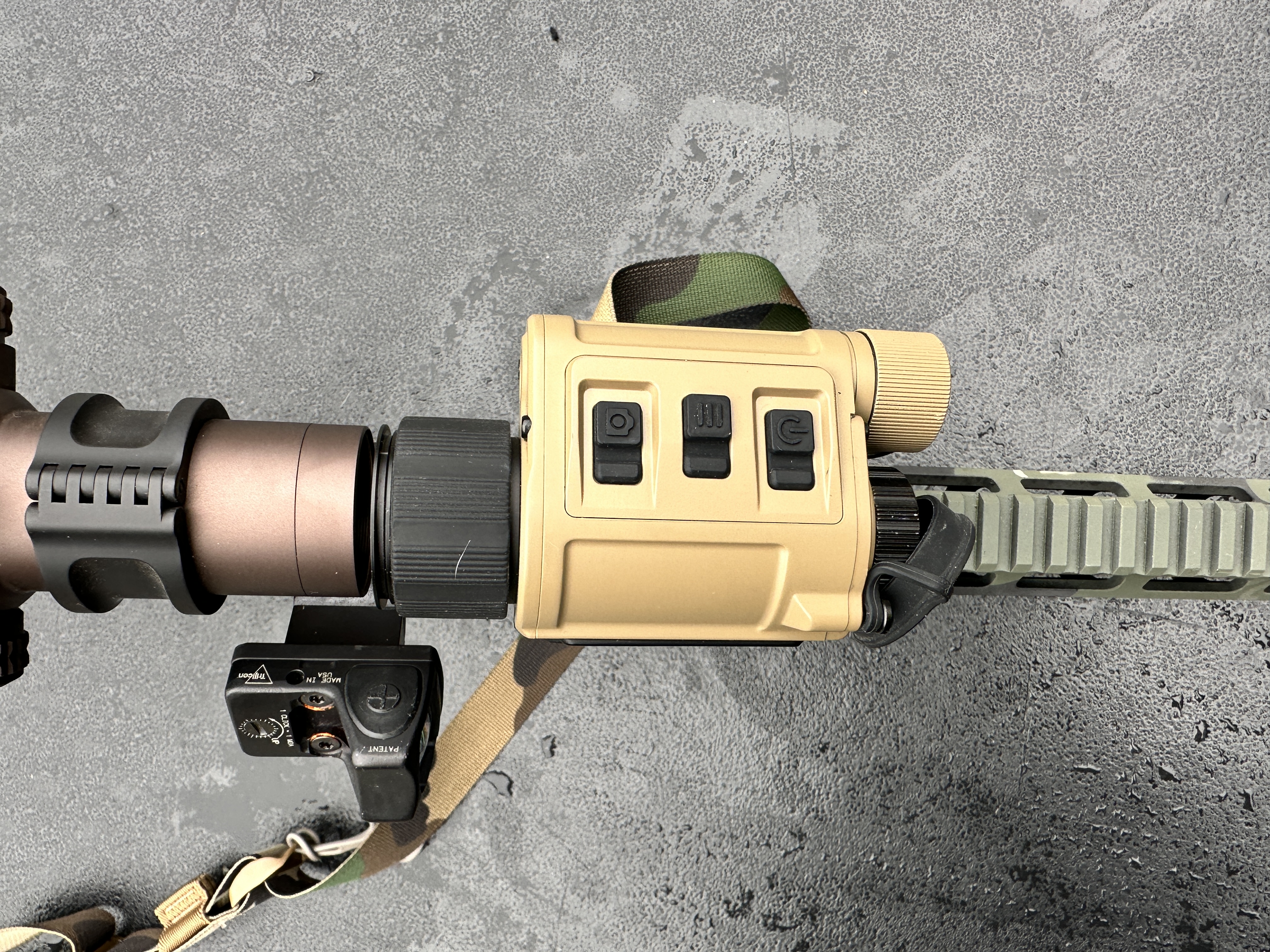
Thermal optics are expensive, and there’s no way to avoid paying for performance. But you can choose how much your thermal does. For example, you can spend $4,000 on a thermal scope, but it will only be useful as a weapon sight. On the other hand, you can spend $4,000 on a Rico Micro, and you’ll have a scope, clip-on, hand-held monocular, and a helmet-mounted monocular all in one unit. That’s a pretty compelling feature set, especially if you want one thermal optic that can do it all.
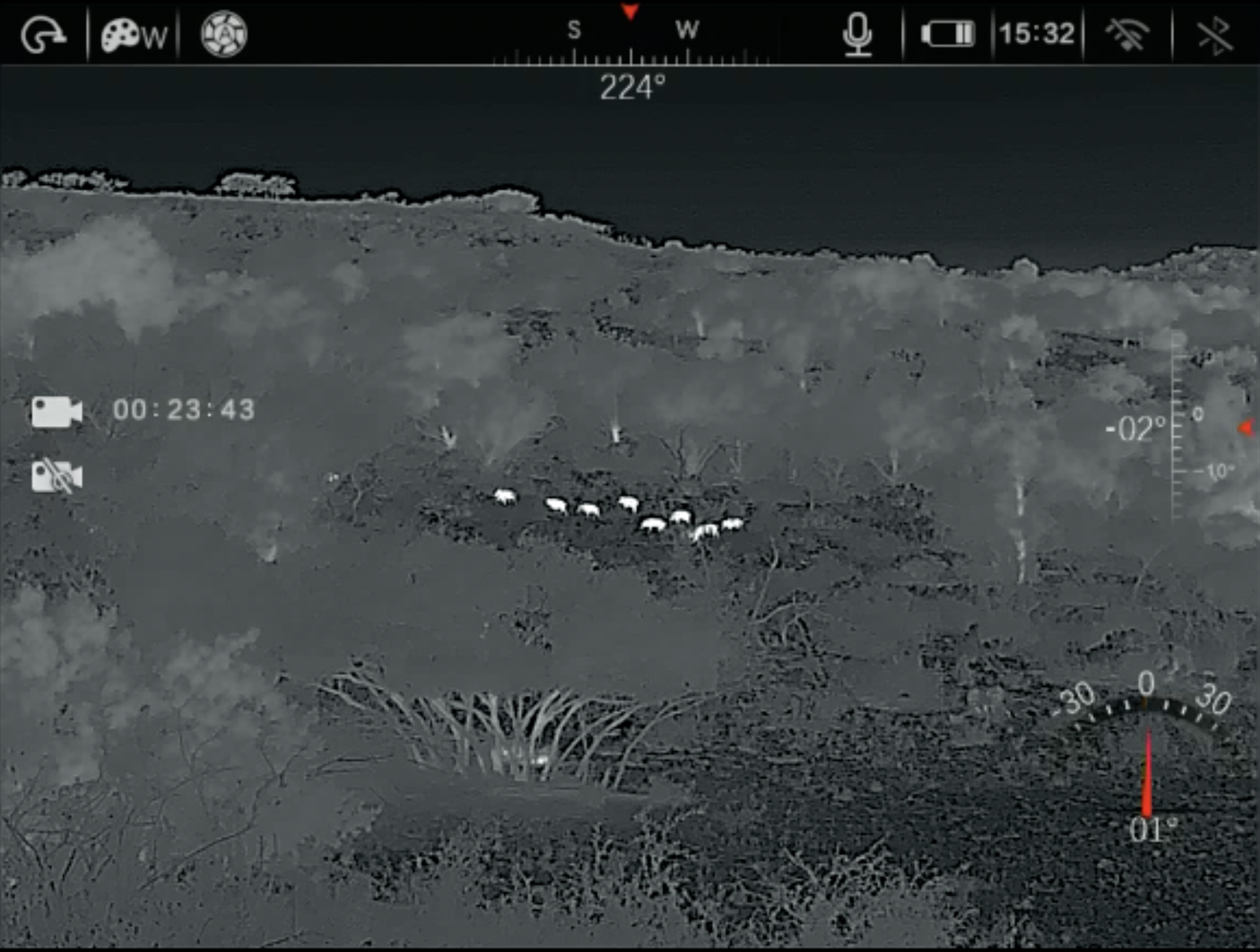
I tested the Rico Micro on a South Texas hog hunt where I spent most of my time high rack hunting. That meant fast shooting at moving pigs from 30 to 200 yards. I mounted the Rico Micro in front of a Vortex Razor 1-10 set on 1x and pre-adjusted my focus for 50 yards. After an hour riding around, and blasting a few skunks, we spotted a group of bigs a touch over 100 yards away. They were moving left to right, trying to get up and over a hill. I threw the scope to my eye and had a nice wide field of view. Then, I caught the pigs at the edge of the scope and panned left to get on one. I squeezed off two quick shots and heard a loud squeal.
One of the key challenges to the place I was hunting was the large number of exotics and other animals we weren’t allowed to shoot. This made target identification a big deal and I needed to quickly focus the thermal on a running animal, identify it, and then make a shot at it. The Rico Micro’s strength isn’t quick focusing or high-detail at long distances, so it left me wanting a dedicated thermal scope in that scenario. But let’s say I were hunting a feeder, the Rico Micro would be an amazing option for turning a day optic into a night optic. I did find the focus easier to manage when the Rico Micro was used as handheld, especially inside 50 yards.
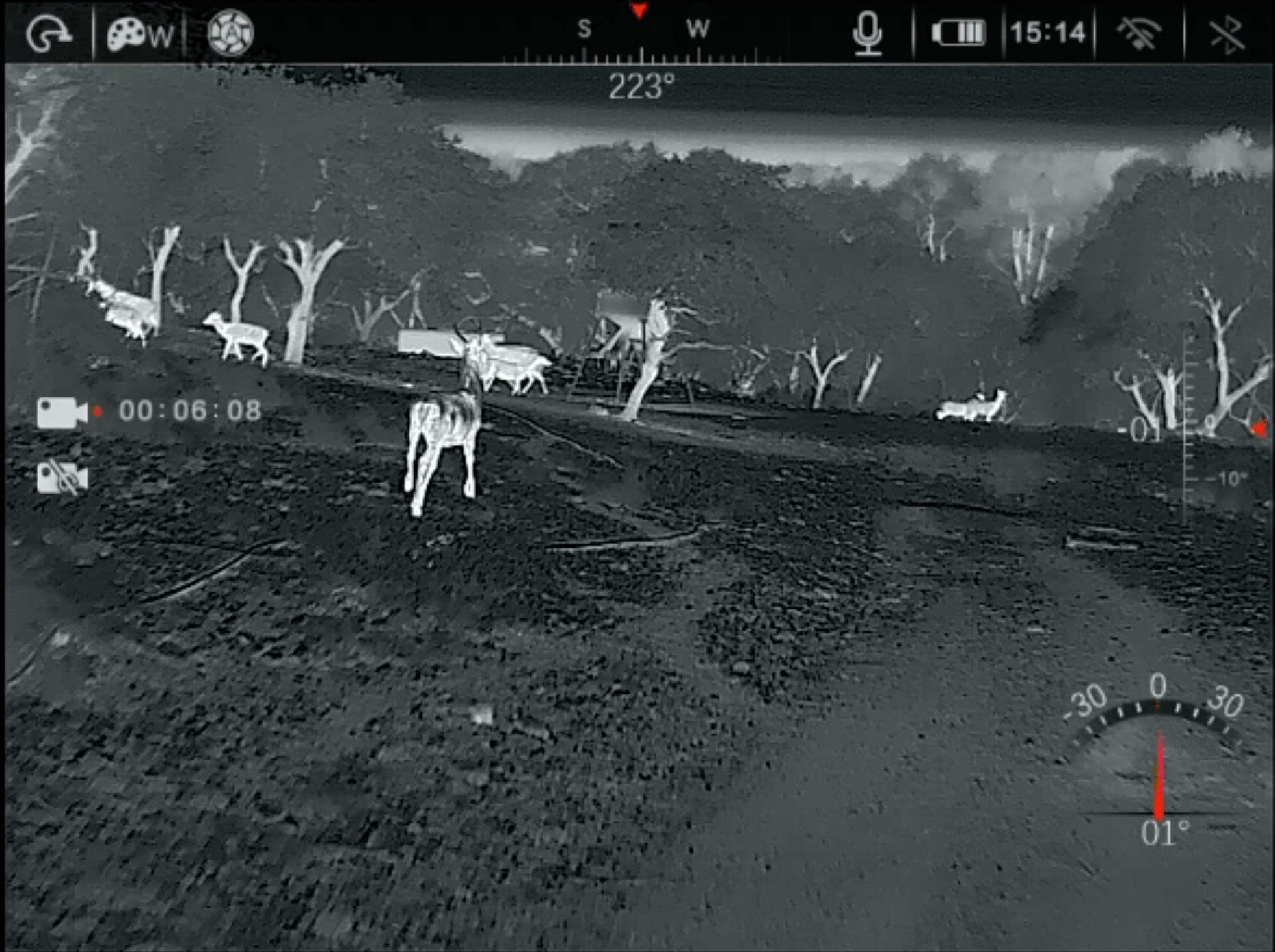
After hunting with the Rico Micro, I think it’s an excellent option for someone who wants a quality monocular that can also be used as a clip-on or scope for close-range (inside 100 yards) hunting.
Most Durable: Armasight Contractor 640 3-12×75 Thermal Weapon Sight
Pros
- Supported by Armasight mobile app
- Elevation and windage turrets control zoom, palettes, and reticle choices
- Ships with premium Pic-rail quick-detach mount
- Intuitive dialing mode function
- Aggressively textured objective lens focus control
- Picture-in-picture mode
- Internal GPS projected on mobile app
- 75mm objective lens
Cons
- At around $5,500, a hefty investment
- Menu navigation is clunky
Score Card
- Ease of Set-Up: Good
- Connectivity: Poor
- Thermal Performance: Very Good
- Shootability: Very Good
- Field-Worthiness: Excellent
- Price/Value: Good
Key Features
- 640×480-microbolometer thermal sensor
- 1024×768 AMOLED display
- 2,800-yard detection on human-sized target
- 3-12x magnification
- 4 hour run time at 20 degrees
- 4 hours onboard video recording capability
- Accepts standard CR123A batteries
- 8 reticle choices
- WiFi and Bluetooth connectivity
- Integrated inclinometer
This is a military-grade thermal. Or as its name implies, maybe a mercenary-grade thermal. In either case, the Contractor delivers excellent images behind its 75mm objective lens and decently resolute sensor and display.
The alloy-metal sight is possibly the most overbuilt thermal in the class. From its extremely positive on/off switch to its cable-tethered battery cap to its MIL-STD compliance for reliable use in all weather conditions, this is one unit that’s unlikely to crap out on a winter coyote hunt or fail after a season of knocking around in a side-by-side.
The unit’s martial DNA is revealed by its stadiametric rangefinder, which uses human-sized targets for reference, and its eight selectable reticles tend toward military ordnance. My favorite is a chevron with bullet-drop references that conform to 5.56 and .308 rounds with standard velocities. Users can adjust the BDC reticle to the trajectories of their own loads. The Contractor has a built-in Pic rail to accept accessories, from an external rangefinder module to a night-vision illuminator. The Armasight also ships with an excellent quick-detach rail mount that is high enough to allow the big 75mm objective lens to ride above most rifle barrels.
The Contractor features a ½ MOA boresight feature, making zeroing the unit quick and easy. It has four hours of onboard video storage and the ability to live-stream images through a phone app. For some reason, I was unable to download images from the device, either wirelessly via Bluetooth and WiFi connection or via USB cable.
The Armasight app allows users to build their own ballistic profiles and then upload them to the thermal. The app also features a map with both streets and terrain views that gives users the ability to drop and share waypoints.
Taken together, those attributes provide an exceptionally durable and versatile thermal sight that is at home on a law enforcement or military carbine but which will rule most hog and predator hunts. Its ability to easily share images is a little lacking, but that’s about the only demerit on this otherwise exceptional thermal scope.
Best New Thermal Sight: X-Vision Impact 350
Pros
- 8-hour battery life
- Very compact
- Quick-detach Pic rail included
- Side-mount Pic rail for accessories
- Intuitive button functionality
- 10 electronic reticles
- Picture-in-picture mode
Cons
- At around $6,000, a hefty investment
- Underwhelming mobile app
Score Card
- Ease of Set-Up: Very Good
- Connectivity: Poor
- Thermal Performance: Good
- Shootability: Very Good
- Field-Worthiness: Good
- Price/Value: Fair
Key Features
- 640×480-microbolometer thermal sensor
- 1024×768 AMOLED display
- 35mm objective lens
- 2-16x magnification
- Hotspot tracking
- Stadiametric rangefinder
- 10 reticles, 6 color palettes
- 1,500-yard detection range
Just as traditional daylight optics suffer from sameness, a certain amount of cloning defines the rising category of thermal devices. Not only do many thermal scopes and monoculars look alike, but many share similar — in many cases, identical — internal works. In part that’s because there are only so many companies making thermal sensors, the beating heart of most units, and most companies are rushing OEM products to market without developing proprietary designs.
That’s the case with X-Vision, which has a very full line of thermal scopes, binoculars, hand-held viewers, and even a very interesting reflex sight that’s included elsewhere in this roundup.
Most of X-Vision’s products look pretty much the same and have similar functions. The difference is mainly in image quality. So you have the Impact 150 with a 384×288 thermal sensor that has a 1,100-yard range that retails for $3,000, then the Impact 250 for $1,000 more that has a more powerful sensor that gives it a 2,200-yard range. We tested the Impact 350, powered by what’s become the industry standard for high-end thermals, a 640×480 sensor. The Impact 350 retails for $6,000.
While that’s a steep price for a fairly pedestrian unit, it has a couple of appealing attributes, including a “hotspot tracking” feature that recognizes and follows either especially hot or cold targets and the ability to accept external laser rangefinding modules. The Impact 350 has an impressive 8-hour run time between battery charges, and it has industry-standard stadiametric rangefinding, picture-in-picture mode, selectable reticles, and six color palettes. Adding to its plug-and-play capability, the unit mounts easily with its integrated Picatinny rail, and is a breeze to zero.
One of the unit’s most appealing attributes is its simple and very functional single-button operation. Push the button to navigate between menu items, then turn it to select operation. A separate button activates the photo/video mode. It’s a handy and fast operating system.
What’s neither handy nor fast is X-Vision’s underwhelming mobile app. We had a hard time getting it to connect to the thermal sight or to transfer video and photo content.
Best Hunting Thermal Sight: Steiner Nighthunter S35 Gen II
Pros
- Includes quick-detach rail mount 2,000-yard detection range
- Extremely robust housing 9-hour battery life
- Side focus dial
Cons
- Low magnification limits the reach
- Fairly pedestrian mobile app
Score Card
- Ease of Set-Up: Very Good
- Connectivity: Good
- Shootability: Very Good
- Thermal Performance: Good
- Field-Worthiness: Excellent
- Price/Value: Very Good
Key Features
- 640×512-microbolometer thermal sensor
- 1280×960-pixel display
- Accepts twin 18650 batteries
- 1X magnification
- 32 GB internal video/photo memory
- Dual battery system
- Choice of 10 reticles
- Picture-in-picture mode
- Stadiametric rangefinder
If you accept that many Asian-sourced thermals are clones, sharing at least sensors and other internal components, then this German-designed, American-sourced thermal scope is a stark departure from its peers.
But its design and function split the difference between European thermals, which are mainly clip-ons, and the growing crowd of dedicated thermal scopes that feature multiple color palettes, reticle choices, and other features. The Nighthunter S35 GenII doesn’t deviate from that standard. In addition to the palettes and reticles, it has picture-in-picture mode, hotspot tracking, stadiametric ranging, and connectivity to a mobile app.
What separates it from the field is its excellent handling. Instead of a large knurled focus ring on the objective lens bell, the Steiner has a left-side focus knob that turns with tight precision and brings targets into sharp focus. As a left-handed shooter, I might want ambidextrous focus knobs, but the left-side location is perfect for righties. Adding to its intuitive operation, the menu and submenu selections are accessed via a large rotary control just behind the top-side battery pack. A long push brings up the menu, and it’s easy to dial between choices, then make your selection with a short push of the button. It’s easy, smart, and very tactile. In the field and while wearing gloves, we found it one of the fastest operating systems of the entire crop of thermal sights.
The Nighthunter ships with an excellent quick-detach rail mount. Its short and compact build makes it a great choice for micro-action bolt guns and AR carbines.
Powered by a pair of rechargeable 18650 batteries that provide about nine hours of run time, the unit is rugged, though some users have reported glitchy operation with heavy-recoiling rifles. While most Steiner thermals connect to the brand’s excellent Steiner Connect app, the Nighthunter S35 GenII has its own app of the same name. It’s fairly underwhelming, offering streaming and image transfer and the ability to control menu and submenu selections via your phone, but it doesn’t have an integrated ballistics feature or other add-ons.
At about $4,500, the Nighthunter S35 GenII lands squarely in the middle of the pack in terms of price, but for the amount of performance in a plug-and-play thermal, it’s a fair price for a smart and functional thermal scope.
Great Buy: Burris BTS35 v3
Pros
- At about $3,000, a very accessible price
- Includes cantilever Picatinny rail mount
- Accepts standard rechargeable 18650 battery
- Stadiametric rangefinder guide is fast and accurate
- Fast and simple rotary control
- Sleek low-profile design
- Connects to the very good Burris Connect app
Cons
- 6-hour run time on the low end of field
- Photo/video activation controlled by power button
Score Card
- Ease of Set-Up: Very Good
- Connectivity: Good
- Thermal Performance: Good
- Shootability: Very Good
- Field-Worthiness: Very Good
- Price/Value: Excellent
Key Features
- 640×480-microbolometer thermal sensor
- 1024×768-pixel display
- 14x magnification
- 1-8x digital zoom
- 11 color palettes
- 10 reticle choices
- Picture-in-picture mode
- Optional dark mode
This excellent thermal scope has plenty of attributes that its peers share. But to deliver a very good, durable, and shootable thermal backed by an excellent mobile app for $3,000 is noteworthy. Consider that many of the units in this test that have nearly identical specifications and functionality to the Burris cost twice as much.
The BTS35 v3 isn’t without its shortcomings. Its resolution, while good, isn’t mind-blowing, and its single 18650 rechargeable battery runs for about four hours in the cold, though we got six hours out of it in warm weather. And the button that activates the camera is the power control. We ran into a couple instances where we wanted to shoot a video but instead powered down the scope.

But each of those demerits has an upside. It’s a cinch to trade out batteries in the field, thanks to the accessible battery compartment. Aside from the camera trigger, the Burris’s other control is a single do-everything knob, similar to that on the Steiner, which makes sense because the Beretta family of companies owns the sister brands. A long push brings up the menu, and scrolling between various operations is simply a matter of turning the dial and making a short push to activate your choice. In the heat of a winter coyote hunt, with incoming targets and gloved hands, the navigation is fast, simple, and effective.
The BTS35 has a fairly standard-resolution sensor and display. Its detection and target-recognition ranges are right in the middle of the field, and it has selectable reticles and nine different color palettes, and picture-in-picture mode. Burris has spent a good deal of time, since the company came out with its rangefinding Eliminator rifle scope, on building out its mobile app. Called Burris Connect, it’s one of the simplest mobile apps on the market, and integrates with the BTS35 relatively seamlessly.
The Burris is solidly built, comes with an excellent quick-detach cantilever rail mount, and is covered by a limited 3-year warranty (two years for international customers). In all, the BTS35 v3 delivers a ton of performance for a very fair price, and is a worthy recipient of our Great Buy award for thermal sights.
Best Laser-Rangefinding Thermal Scope: ATN ThOR5 LRF
Pros
- Mounts on standard 30mm rings
- Excellent built-in rangefinder
- Traditional scope mounting geometry
- Cant indicator
- Robust 3-year warranty
- At about $3,200, a fair value
Cons
- Onboard photo/video storage
- Frustrating menu navigation
- Unreliable app connectivity
Score Card
- Ease of Set-Up: Good
- Connectivity: Poor
- Thermal Performance: Very Good
- Shootability: Very Good
- Field-Worthiness: Fair
- Price/Value: Very Good
Key Features
- 640×480-microbolometer thermal sensor
- 1024×768-pixel display resolution
- 4-32x magnification
- 9-hour battery life
- Built-in laser rangefinder with 1,000-yard range
- Integrated ballistic calculator
- 8-pattern reticle plus ability to create reticles
You’re going to need to set aside a chunk of time to unlock all the features of this remarkable thermal scope. That’s because there are so many functions and sub-functions, but also because the user interface is frustratingly Byzantine.
The payoff for navigating the convoluted menu is unlocking the abundant capabilities one of the most versatile thermal scopes on the market. The ThOR (not a typo, that’s how ATN names its flagship thermal) has one of the most precise and useful integrated laser rangefinder in the field. But it also has features like manual pixel healer to improve the displayed image, an integrated ballistics calculator, a cant indicator, compass header, wind indicator, and through an available app, the ability to create and share reticles with other users.
ATN is one of the OGs of the thermal market, and early generations were defined by glitchy operation. That’s still an issue with this fifth-generation ThOR, but it’s much more stable than previous iterations. The 4-32×50 model that we tested costs $3,295, pretty good for its boost in sensor resolution. Our model has a 640×480 processor; pay attention since ATN also sells a ThOR 5 with a 320×240 sensor that doesn’t have nearly the resolution or the reach of the more powerful thermal.
You’ll need your own set of 30mm rings to mount the ATN. While many brands are shipping quick-detach rail mounts with their sights, the ability to use your own rings gives users more mounting options. Field tests confirmed the laser rangefinder’s reach to 1,000 yards, and combined with the ballistics function, we made shots out past 500 yards with a variety of calibers.
The ThOR 5 has some significant shortcomings. First, it stores video and photo content on an onboard micro SD card. If you want to share images, you have to manually download the data. While ATN has a fairly robust mobile app — and after working our way through the tedious WiFi connection — we found that it doesn’t yet have the ThOR 5 profile available for linkage. We expect that to change in the coming months.
Users must also manually input important components of ballistics, including altitude, temperature, humidity, and barometric pressure. More advanced thermals fetch that environmental data from onboard sensors.
Our final gripe is with the 7-button navigation. It takes some time to learn the functions of each button, and in a controlled environment we got pretty good with riffing through menu options and selecting various functions. But in the field, while wearing gloves and in the hectic moment of incoming coyotes, the buttons are too small and closely configured to operate effectively. At one point, while trying to laze a coyote, switch color palettes, and increase magnification simultaneously, we were pushing and releasing buttons like frenzied trumpet players.
But if the interface is frustrating, the capabilities of this scope are impressive. The ability to mount it to a rifle, zero it in just a couple shots, then engage targets out to the very limits of its recognition range make it a relatively affordable thermal sight worth a hard look.
Best Thermal Reflex Sight: X-Vision Flex 2
Pros
- Quick-detach Picatinny rail mount included
- Functions as weapon-mounted sight or hand-held viewer
- Compact, at 2.6×3.5×3.5 inches
- Picture-in-picture mode
- Suitable for carbines, shotguns, and rail-mount handguns
Cons
- No mobile app connectivity
- At $3,500 pretty pricey
- Significant pixelization at higher magnifications
Score Card
- Ease of Set-Up: Very Good
- Connectivity: Very Good
- Thermal Performance: Good
- Shootability: Very Good
- Field-Worthiness: Good
- Price/Value: Fair
Key Features
- 384×288-microbolometer thermal sensor
- 800×600-pixel AMOLED display
- 1-4x magnification
- 25mm objective lens
- 650 nm red laser
- 32 GB internal video/photo memory
- 5-hour battery life
- 1,700-yard detection range, 750-yard recognition range
- 4 color palettes, 6 reticle options
If thermals generally impress users with their ability to “see” into the night, this little marvel adds to the category’s wow factor by doing triple duty as a weapon-mounted thermal, a laser-emitting sight, and a hand-held thermal viewer.
The Flex 2 packs a lot of capability into a tiny build. Measuring just 2.5×3.5 inches, it goes just about anywhere. But because its 2.7-inch screen dominates its back, users have a relatively large image to guide either the reticle or the red laser aiming point. The unit is a little cumbersome to use as a hand-held unit, but happily X-Vision sells a rail-mount handle for $129 that makes hand-held use stable, and as a bonus it stores an extra battery.
The Flex 2 has a good number of thermal features, from picture-in-picture mode, the choice of six reticles in four colors, and five color palettes. But its image is limited by its lower-resolution sensor. You don’t notice its shortcomings much at 1-power, but as you ramp up the magnification toward the 4-power top end, the image gets pretty ragged.
We’d also like to see connectivity to a mobile app. While the Flex 2 stores up to 32 GB of video and photo content onboard, the process of extracting the images from the unit isn’t straightforward.
But we’re happy to see the thermal product line expand beyond the narrow use-case of carbines for hogs and predators. With the Flex 2, the world of thermal hunting and shooting extends to shotguns, pistols, and just about any other weapon with a rail mount. And its bonus capability as a thermal viewer adds a ton of value to this handy little unit.
Best Large-Caliber Thermal Rifle Scope: Trijicon REAP-IR 60
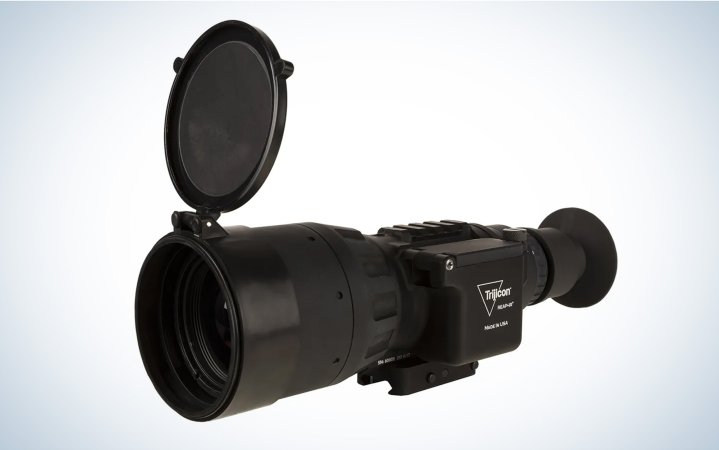 ON SALE NOW
ON SALE NOW
Trijicon
Pros
- Made in USA
- Thumbstick control
- Big and tactile image focus ring
- Versatile Q-LOC integrated mounting hardware
- Useful light-blocking eye guard
- Extremely rugged
- Ships in premium hard case
Cons
- At about $9,700, pricey
- Thumbstick operation takes some practice
- No Wi-Fi or Bluetooth connectivity
- Hard to download images
Score Card
- Ease of Set-Up: Good
- Connectivity: Fair
- Thermal Performance: Very Good
- Shootability: Good
- Field-Worthiness: Very Good
- Price/Value: Fair
Key Features
- 640×480 thermal sensor
- 12-micron image sensor
- Huge 60mm germanium objective lens
- 3x magnification with 8x digital zoom
- Five reticle choices
- Rugged aluminum housing
The 60mm REAP-IR is just one of a trio of similar REAP models from Trijicon. While they share most internal components and specs, the 60mm version costs about $2,000 more than the 24mm, and nearly $1,000 more than the 35mm model. That should give you an idea of how pricey the temperature-differentiating lens element, germanium, costs to procure and shape. The 60mm has a manual objective focus; the other units have fixed focus.
All of the Trijicons are battle-tested, durable units built to take a pounding. The aluminum chassis is tough and heavy; the 60mm model weighs about 2.5 pounds. That burly build is an indication of the REAP’s military DNA. So is the Trijicon’s Q-LOC mount and bullet-proof battery compartment — the unit takes two CR123 cells, which in our experience tend to do better in cold weather than rechargeable batteries. The Trijicon gave us a full four hours of run time in just about any temperature condition.
With 640×480, 12-micron sensor resolution, the REAP-IRs have fairly pedestrian thermal performance. We noted some significant ghosting of images in all the modes, but the vanadium oxide sensor seems to have a little better daylight resolution than its peers. The Trijicon’s palettes are a little limited; it has black hot and white hot and a very useful “edge detect” mode that would be especially helpful in personal-defense situations.
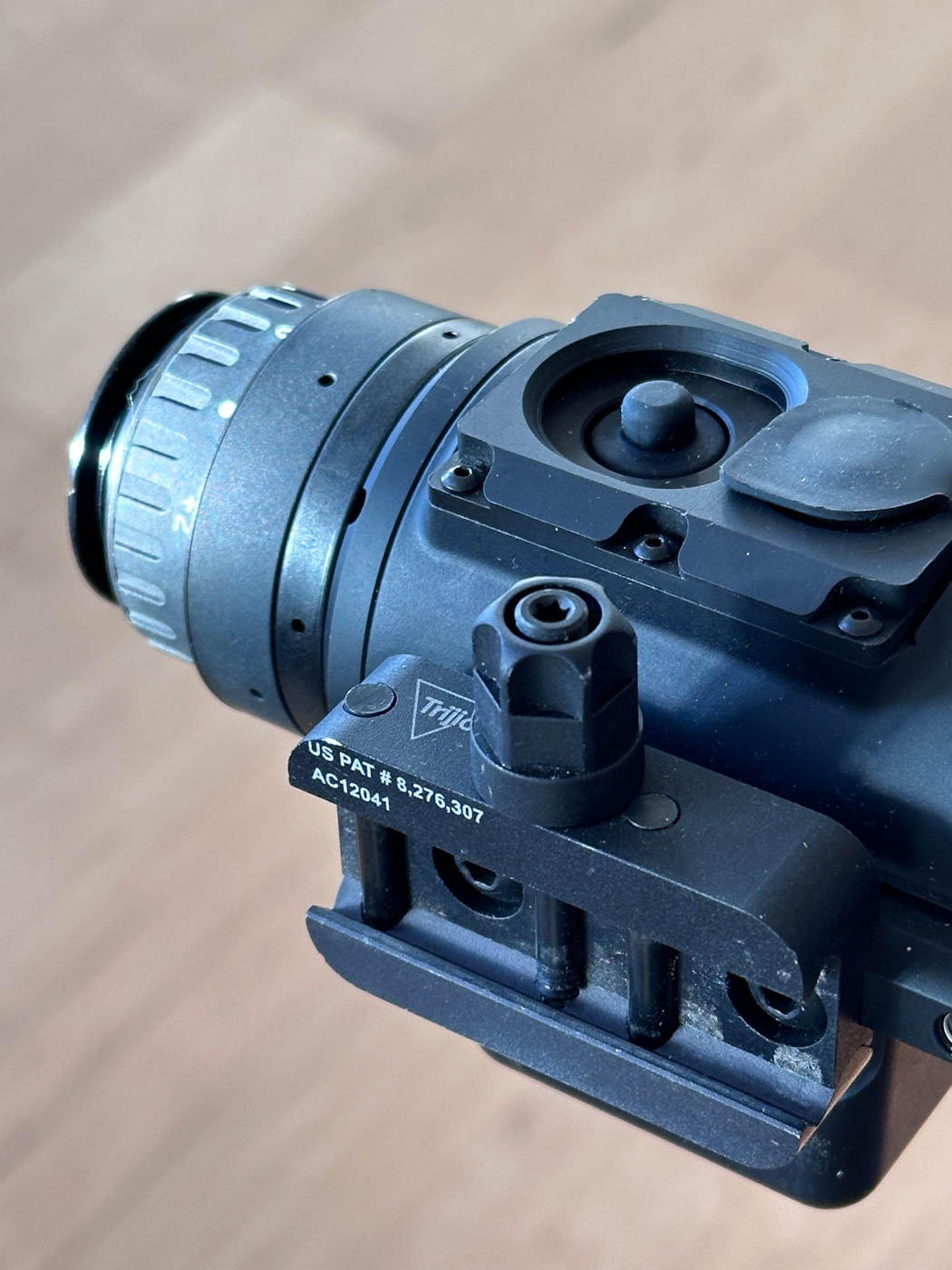
Both Fossum and I struggled with the joystick operation in our first outings, but the more I use it the more I appreciate its simplicity. Push the stick to activate the unit, then “drive” the stick in all four cardinal directions to move between modes and then pick the feature you want to manipulate. You don’t have to navigate different buttons or worry about inadvertently turning off the power or shifting between modes.
Fossum also noted a curious detail of the Trijicon. When the lens is covered during start-up, the image resolution is much improved. He also noted that covering the lens in the field, then refreshing the image, produced far better resolution than when he left the lens uncovered.
Also of note are the selectable reticles, which range from classic duplex crosshair, MRAD, and MOA, plus bullet-drop reticles tuned to .223 Rem., .308 Win., and 300 Blackout.
If you’re looking for a thermal scope that can handle the punishment of a heavy-recoiling caliber, or won’t flake out in a rut-jumping side-by-side or pickup, this is a great choice. You may be disappointed in its limited feature set, but it’s a reliable, rugged companion for just about any shooting situation.
Best Entry-Level Thermal Scope: Sightmark Wraith Mini Thermal
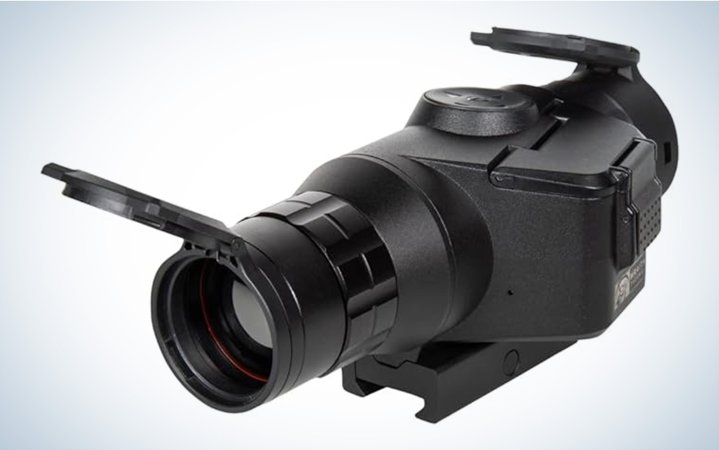 ON SALE NOW
ON SALE NOW
Sightmark
Pros
- At about $2,000, relatively affordable
- Easy-mounting Picatinny hardware
- Light, 19.3-ounce weight
- Easy, one-button navigation
Cons
- Only on-board video and image recording
- Relatively low thermal resolution
- No Wi-Fi or Bluetooth connectivity
Score Card
- Ease of Set-Up: Good
- Connectivity: Poor
- Thermal Performance: Good
- Shootability: Good
- Field-Worthiness: Fair
- Price/Value: Very Good
Key Features
- 384×288 sensor resolution
- 1024×768 OLED display resolution
- 17 pixel pitch
- 1-8-power digital zoom
- 35mm objective lens
- 1,400-yard detection range
- Five color palettes
- 10 reticles

If you’re looking for a dedicated thermal rifle scope that won’t cost more than your car, this very capable Sightmark is a good choice. It has some significant deficiencies compared to premium options, but with a little snooping you should be able to find this unit for under $2,000.
Among its many attributes, the Sightmark is produced by Pulsar, arguably the leading thermal brand in the U.S. The engineers and product managers know thermals, and their Lone Star constituency keeps them close to the nighttime hog hunting that’s a fertile proving ground for American thermals.
All that context has produced a capable and affordable thermal. It’s useful to know that the original Wraith was a night-vision unit, and its exterior design retains references of a helmet-mounted unit. But the Wraith thermal mounts to a weapon via a very handy Picatinny adapter, and the single-button operation makes field deployment fast and intuitive.
If there’s a downside to this unit, it’s in the field. The Wraith is an adequate thermal, but hunters who have used higher-resolution units will be disappointed in image detail and image recording capabilities. The 384×288 sensor is half the resolution of most units, and the fact that the Sightmark doesn’t connect to a mobile app limits its utility.
We found that the Wraith performed best when conditions were optimal, which in thermal operation means broadside animals inside 200 yards. The unit is certainly capable of service out to 1,000 yards, but the farther out, the more undefined images are, which means shooters need to have some additional context in order to make sure of anchoring shots at targets. In other words, out a ways, a feral hog can look a lot like your neighbor’s dog through a low-resolution thermal.
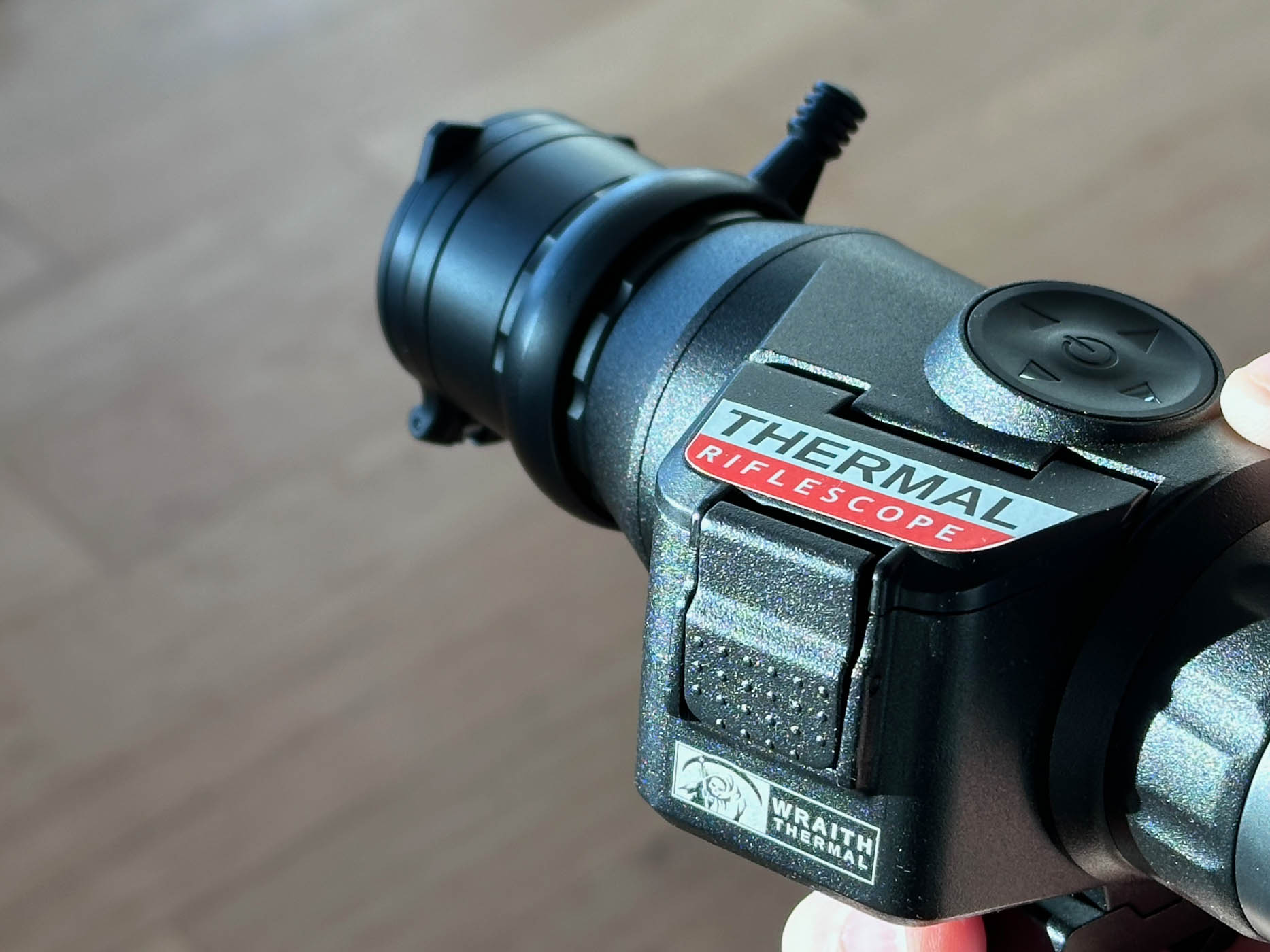
We also had a chronic problem with the battery compartment lid flying open with each shot, which we solved by taping down the spring-loaded hatch. But both Fossum and I worried that the Wraith might not be able to handle heavy-recoiling rifles as well as other thermal rifle scopes in our test.
Still, these are acceptable deficiencies for a thermal scope that costs less than $2,000. For that price, you get five color modes (white hot, black hot, green hot, magenta, and rainbow), 10 different reticles, an easy-mounting base, and enough resolution and menu options to get you in the thermal game.
Best AR Thermal Sight: Sig Echo3
Pros
- Easy to zero
- Connects to Sig’s BDX app and device ecosystem
- Wide angle and wide display
- Motion-activated on/off
- Housing made of tough ballistic-grade polymer
- Made in the USA
- Six-hour run time on two CR123 batteries
Cons
- Not intended for long-distance shooting
- Mini-joystick controller takes some practice
Score Card
- Ease of Set-Up: Very Good
- Connectivity: Very Good
- Thermal Performance: Good
- Shootability: Very Good
- Field-Worthiness: Very Good
- Price/Value: Good
Key Features
- 320×240 thermal sensor with 12-pixel resolution
- 1-6-power x 23mm objective
- Circular 454×454 AMOLED display
- Eight color palettes
- Connects to app and tethered devices through Bluetooth and Wi-Fi
- Easily mounts via Pic-rail adapter
- Focusable lens with handy throw lever
Think of this as a thermal reflex sight. It basically functions as a low-magnification, wide-angle sight that’s suited for personal defense, close-range shooting at night, and pretty much any application that requires an AR.
After field testing this trim, capable unit, though, I pictured it on a close-range hog gun, a nighttime coon rifle, a straight-wall carbine, or even a shotgun. It has that kind of versatility. What it doesn’t have is a long game. While it can detect targets out to about 300 yards, it delivers fuzzy, indistinct images at that range. It’s at its best inside 100 yards, when images are crisp, fairly detailed, and display vibrant thermal signatures. Off a gun, it doubles as an adequate hand-held thermal monocular, thanks to its large display screen.
Sig actually builds two versions of its Echo3. I tested the 1-6×24 version, but there’s also a 2-12x40mm version that has a little more reach, and of course a higher price tag. The lower-power model retails for right around $2,500, about right for the combination of durability, versatility, and utility that it delivers.
Both units have sort of disappointing image resolution, which is more of a function of the low-def sensor than the better digital display. And daylight use wasn’t very effective.
Among the Echo3’s attributes are ease of sighting in. Thermal sights can sometimes be finicky and imprecise, and require toggling through pages of menus in order to get at the right combination of zero settings and reticle adjustments. Not the Sig. It’s easy, straightforward, and if you spend more than two or three shots getting zeroed, you’re probably doing something wrong. We also liked its wide, rounded display, and its ability to receive reticles from the BDX app. That app, which also powers Sig’s Wi-Fi-enabled rangefinders, syncs to the Echo3, allowing range-informed aiming solutions to be shown in the display. The BDX app also facilitates image transfer.
The joystick control is similar to that of the Trijicon and it shares a steep learning curve with that unit. But once you get the hang of it, it’s an elegant and simple way to toggle between functions.
In all, it’s a useful AR-mounted thermal that has wide utility for shooting situations inside 100 yards. Beyond that, and you may be wishing you had a little more magnification and resolution.
Best Value Clip On: AGM Rattler TC35-384 Thermal Clip-On
Pros
- Good battery life and can run on an external battery pack
- Can be moved from rifle to rifle
- Allows the user to use their day scope’s turrets for longer shots
- Records video and images
Cons
- No sound recording with video
- It takes about 3 seconds to get a video recording started
Key Features
- Weight: 0.93 pounds
- Magnification: 1x (2x,4x,8x digital)
- Resolution: 384 x 288
- OLED Display: 748 x 561
- Objective Lens Diameter: 35mm
- Detection Range: 1,235 Yards
- Frame Rate: 50 Hz
- Pixel Pitch: 17 um
- Waterproof and Shockproof: IP67 Rating
- External Power Supply Capable
- 4.5 Hour Runtime on CR123 batteries
- 16 GB Storage for Videos and Pictures
The AGM Rattler TC-35 is the best value thermal clip on for a few important reasons: digital zoom, external battery compatibility, and video recording.
The biggest standout is its digital 2x, 4x, and 8x zoom. This makes it quite useful as a handheld monocular. If you want to use it as a dedicated monocular, I’d pick up the optional eye piece for about $300. The eyepiece makes the image appear larger to your eye while using it as a monocular. Even without the eye piece, it’s a serviceable monocular when it’s not on your gun.
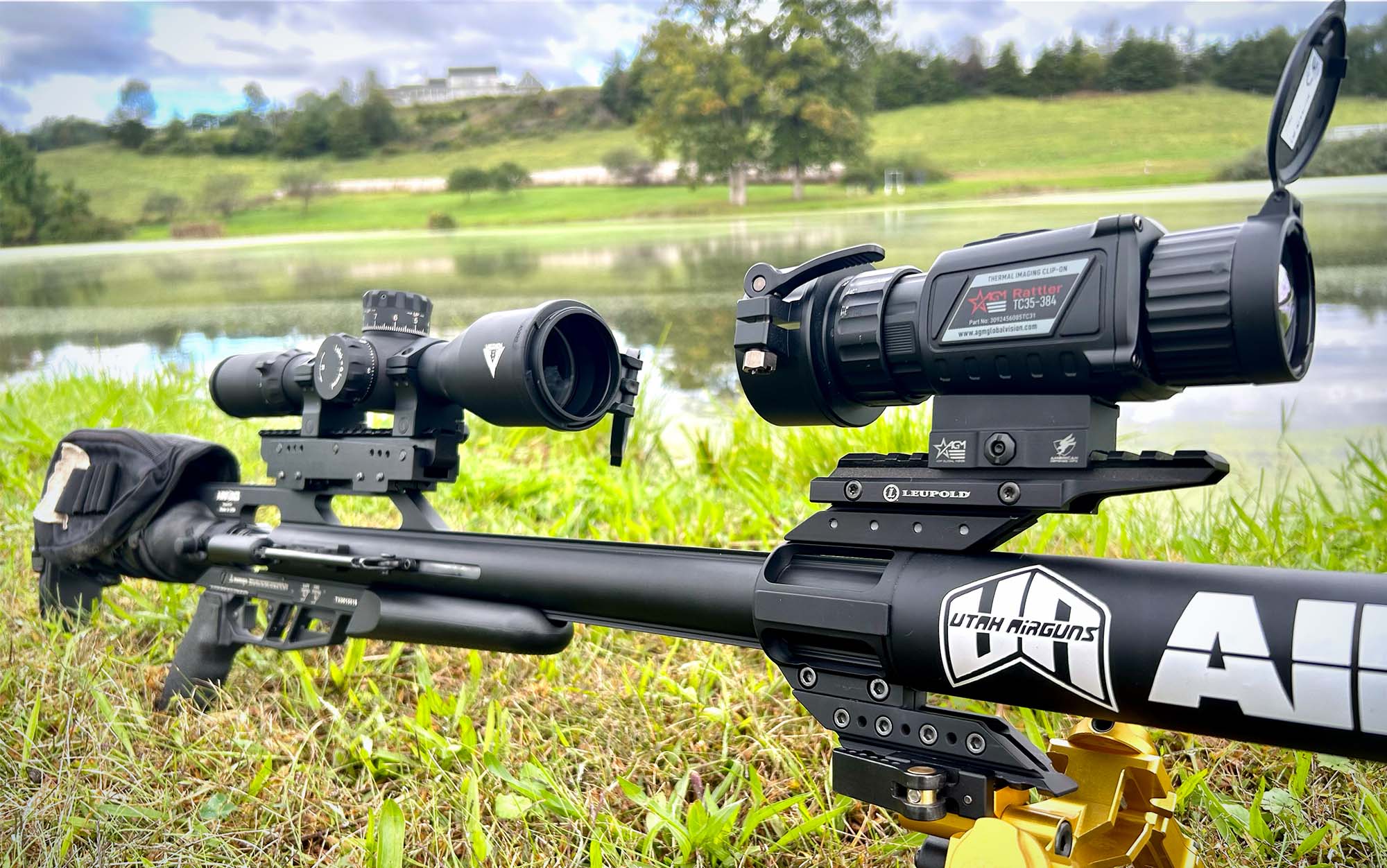
The Rattler has external battery capability. This is a huge plus if you want to hunt for more than 4 hours or hunt in extreme weather. Freezing temperatures will kill a normal CR123 battery quickly, but an external battery pack rated for 20 hours will let you hunt without worrying about battery life. External batteries are also easy to wrap a hand warmer around, extending operating time greatly.
The rattler records video and takes photos. It boasts 16 GB of onboard storage, which is plenty to get you through even the most active hunts. Be aware that there is no microphone, so the recordings have no sound. To get around this, I purchased a cheap audio recorder the size of a pack of gum for when I want the audio. Unless you are a YouTuber like me, you probably won’t care much about the audio, but it is worth noting. My only real complaint with the video function is that it requires a long press of 3 to 4 seconds to start. That can feel like a long time when a coyote is passing through.

One thing to remember when using this unit or any other clip-on is that less magnification on your day scope is better. Low magnification lets you see more of the OLED display. More magnification is helpful for longer shots but restricts your field of view. For this reason, I like a second-focal plane scope with low magnification and illuminated reticle. I find the sweet spot to be around 5x magnification when using clip-ons.
My Rattler is incredibly repeatable when taking it on and off of the rifle, holding within 1 inch of zero at 100 yards. I have also found that when attaching it to the scope bell, it can be used on scopes of the same brand and model without re-zeroing the thermal unit. That’s why I own multiple rifles with the same brand and model scope on them. This allows me to choose which rifle is best for the task at hand, whether it be an AR-10, bolt gun, or airgun all without touching the clip-on’s settings.
At about $2700, this optic packs in a ton of features and is a great option for owning the night. — Keith Gibson
Read Next: Best Night Vision Scopes
Things to Consider Before Buying a Thermal Scope

The first thing you should consider if you’re in the market for one of the best thermal scopes is how you’ll use it. Do you want a rifle-mounted scope, with reticle and even a built-in laser rangefinder? If that’s the case, then you’re looking at a fairly expensive subset of thermals. Or maybe you just want a unit to see into the night. A hand-held thermal will do just fine, at a fraction of the cost of the thermal scopes, but without any ability to place after-hour shots.
Second, consider your budget. You can spend anywhere from about $1,000 to well over $10,000 on these devices. But if you’re simply interested in a viewer to detect animals or maybe a car parked at a trailhead, you won’t need all the bells and whistles of a scope. But if you want a plug-and-play scope to shoot coyotes or varmints after legal shooting light, then you should expect to pay well over $3,000 for the most capable rifle-mounted sights.
FAQs
Thermal units range in price from around $1,000 for basic thermal viewers to over $7,000 for the most sophisticated rangefinding scopes. Keep in mind that these aren’t night-vision units, which can cost only a few hundred dollars. Thermal scopes depend on a rare-earth element called germanium, which supplies temperature-sensitive glass for thermal units. Generally speaking, the best combination of attributes, capability, and overall utility of thermal units will set you back around $3,000.
That’s a great question. You’ll generally see a couple of different resolution equations mentioned for thermal devices. One measures the sensitivity of the sensor, or the interface that receives the thermal image. The bigger the numbers, the more detail the sensor is receiving. That’s generally a function of quality components and size of the objective lens. For higher-quality units, look for sensor resolution of about 640×480 pixels. You also want to pay attention to the display sensitivity. That’s a measurement of how much detail you’ll see on the screen of the device. The higher the number, the more contrast and detail you’ll observe. Resolution of 1064×748 provides very good visibility.
There are a number of quality brands on the market, but generally European brands only have thermal sights or what are called clip-on units, intended to be used with a standard riflescope. Units from Russia and Southeastern Europe generally have a good combination of rangefinding riflescopes and hand-helds, though quality is variable. Then there are American brands such as Trijicon and Burris that have consumer versions of their military-grade thermals.
Generally, thermal scopes and viewers are illegal to use in pursuit of game animals, like deer or turkeys. But most states allow their use for non-game animals, like coyotes or raccoons. You’ll have to check with your state’s hunting regulations to see if they’re expressly prohibited. Because they occupy a gray area, it’s a good idea to also check with your local game warden.
Final Thoughts on the Best Thermal Scopes
The best thermal scopes and clip ons are getting more affordable and accessible by the day. Until you are able to see through the darkness and pick up thermal signatures several hundred yards out in the field, you might not think you need one of these devices. But once they reveal all the hidden secrets of the night, you’ll want one just to see what happens around you in the dark.
But not all thermals are created equally. Generally speaking, you get what you pay for, with the cheaper units lacking some crucial attributes, but the most expensive having more modes and capabilities than most people normally need.
- Editor’s Choice: InfiRay BOLT TX60C
- Best Long-Range: InfiRay RICO Hybrid 640
- Best Clip-On Thermal: Pulsar Krypton FXG50
- Most Versatile: iRay RICO MICRO V2
- Best Hog-Killing Thermal: Pulsar Thermion 2 LRF XL50
- Most Durable: Armasight Contractor 640 3-12×50 Thermal Weapon Sight
- Best New Thermal Sight: X-Vision Impact 350
- Best Hunting Thermal Sight: Steiner Nighthunter S35 Gen II
- Great Buy: Burris BTS35 v3
- Best Laser-Rangefinding Thermal Scope: ATN ThOR5 LRF
- Best Thermal Reflex Sight: X-Vision Flex 2
- Best Large-Caliber Thermal Rifle Scope: Trijicon REAP-IR 60
- Best Entry-Level Thermal Scope: Sightmark Wraith Mini Thermal
- Best AR Thermal Sight: Sig Echo3
- Best Value Clip On: AGM Rattler TC35-384 Thermal Clip-On

